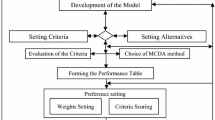Abstract
There is an increasing demand from conservation agencies for site-specific critical loads (CL); unfortunately, there is often very little specific information on a site to determine the important parameters needed to calculate the CL or on the spatial location of the “designated feature” in a site. Determining the most appropriate CL therefore involves using expert judegement to make decisions with incomplete and uncertain information. Endorsement Theory (Cohen, 1985) and Dempster–Shafer statistics (Dempster, 1967; Shafer, 1976) are, respectively, a decision-theoretic and a statistical technique for reasoning under those conditions (uncertainty and incompletness). A key reason for applying these techniques is that they make expert opinion explicit and available for scrutiny. Both techniques have been applied to the problem of setting an appropriate site specific CL, using heathland sites as a case study. Inital findings are encouraging; the uncertainty in expert judgement is made explict, the end results are intuitively reasonable and the methodology apparently acceptable to decision makers.
Similar content being viewed by others
References
Calver, L. J., Cresser, M. S., & Smart, R. P. (2004). Tolerance of Calluna vulgaris and peatland plant communities to sulphuric acid deposition. Chemistry and Ecology, 20, 309–320.
Cohen P. R. (1985). Heuristic reasoning about uncertainty: An artificial intelligence approach. Boston, MA: Pitman.
Comber, A. J., Law, A. N. R., & Lishman, J. R. (2003). A comparison of Bayes’, Dempster–Shafer and Endorsement theories for managing knowledge uncertainty in the context of land cover monitoring. Computers, Environment and Urban Systems, 28, 311–327.
Dempster, A. P. (1967). Upper and lower probabilities induced by a multi-valued mapping. Annals of Mathematical Statistics, 38, 325–339.
Hall, J., Ullyett, J., Heywood, L., Broughton, R., & Fawehinmi, J. (2004). The National Critical Loads Mapping Programme Phase IV. Final report to Defra: July 2001–June 2004 (Contract EPG 1/3/185).
Hornung, M., Bull, K. R., Cresser, M., Hall, J., Langan, S. J., Loveland, P., et al. (1995). An empirical map of critical loads for acidity in Great Britain. Environmental Pollution, 90, 301–310.
Loveland, P. J. (1991). The classification of the soils of England and Wales on the basis of mineralogy and weathering – the Skokloster Approach. A report to the Dept. of the Environment under Research Contract Reference No. PECD 7/12/44.
Rodwell, J. S. (Ed.) (1991). British plant communities. (vol 5) Cambridge, UK: Cambridge University Press.
Shafer, G. (1976). Mathematical theory of evidence. Princeton, N.J.: Princeton University Press.
Soil Survey of England and Wales (1983). Legend for the 1:250,000 Soil Map of England and Wales. Soil Survey of England and Wales. Rothamsted Experimental Station, Harpenden, Herts, AL5 2JQ.
Tangestani, M. H., & Moore, F. (2002). The use of Dempster–Shafer model and GIS in integration of geoscientific data for porphyry copper potential mapping, north of Shahr-e-Babak, Iran. International Journal of Applied Earth Observation and Geoinformation, 4, 65–74.
Acknowledgements
Some of the ideas expressed in this paper were developed during a contract funded by the UK Environment Agency, project manager, Dr. Rob Kinnersley. We wish to thank the referees for important pointers in making this paper more readable.
Author information
Authors and Affiliations
Corresponding author
Rights and permissions
About this article
Cite this article
Wadsworth, R.A., Hall, J.R. Setting Site Specific Critical Loads: An Approach using Endorsement Theory and Dempster–Shafer. Water Air Soil Pollut: Focus 7, 399–405 (2007). https://doi.org/10.1007/s11267-006-9084-8
Published:
Issue Date:
DOI: https://doi.org/10.1007/s11267-006-9084-8




